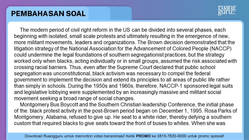Iklan
Pertanyaan
The modern period of civil right reform in the US can be divided into several phases, each beginning with isolated, small scale protests and ultimately resulting in the emergence of new, more militant movements, leaders and organizations. The Brown decision demonstrated that the litigation strategy of the National Association for the Advancement of Colored People (NACCP) could undermine the legal foundations of southern segregationist practices, but the strategy worked only when blacks, acting individually or in small groups, assumed the risk associated with crossing racial barriers. Thus, even after the Supreme Court declared that public school segregation was unconstitutional, black activism was necessary to compel the federal government to implement the decision and extend its principles to all areas of public life rather than simply in schools. During the 1950s and 1960s, therefore, NACCP-1 sponsored legal suits and legislative lobbying were supplemented by an increasingly massive and militant social movement seeking a broad range of social changes.
Montgomery Bus Boycott and the Southern Christian leadership Conference, the initial phase of the. black protest activity in the post-Brown period began on December 1, 1995. Rosa Parks of Montgomery, Alabama, refused to give up. He seat to a white rider, thereby defying a southern custom that required blacks to give seats toward the front of buses to whites. When she was jailed, a black community boycott the city's buses began. The boycott lasted more than a year, demonstrating the unity and determination of black residents and inspiring blacks elsewhere.
Martin luther King, Jr., who emerged as the boycott movement's most effective leader, possessed unique conciliatory and oratorical skills. He understood the larger significance of the boycott and quickly realized that the nonviolent tactics used by the Indian nationalist Mahatma Gandhi could be used by southern blacks. l had come to see early that the Christian doctrine of love operating through the Gandhian method of no violence was one of the most potent weapons available to the Negro in his struggle for freedom, he explained. Although Parks and King were members of the NACCI~ the Montgomery movement led to the creation in 1957 of a new regional organization, the clergy-led Southern Christian leadership Conference (SlCC) with King as its presidents.
King remained the major spokesperson for black aspirations, but, as in Montgomery, little-known individuals initiated most subsequent black movement. On February 1, 1960, four freshmen at North California Agricultural and Technical College began a wave of student sit-ins designed to end segregation at southern lunch counters.
These protests spread rapidly throughout the South and led to the founding, in 1960, of the student Non-Violent Coordinating Committee (SNCC). This student led group, even more aggressive in its use of nonviolent direct action tactics that King's SlCC, stressed the development of autonomous local movements in contrast to SClCs strategy of using local campaign to achieve national civil rights reforms.
SOAL SBMPTN REFERENSI 2020 What does the word 'he' (line 20) refers to?
SOAL SBMPTN REFERENSI 2020
What does the word 'he' (line 20) refers to?
Mahatma Gandhi
Martin Luther King, Jr
Rosa Parks
SCLC
SNCC
Iklan
N. Puspita
Master Teacher
1
0.0 (0 rating)
Iklan
Pertanyaan serupa
RUANGGURU HQ
Jl. Dr. Saharjo No.161, Manggarai Selatan, Tebet, Kota Jakarta Selatan, Daerah Khusus Ibukota Jakarta 12860
Produk Ruangguru
Bantuan & Panduan
Hubungi Kami
©2025 Ruangguru. All Rights Reserved PT. Ruang Raya Indonesia

















